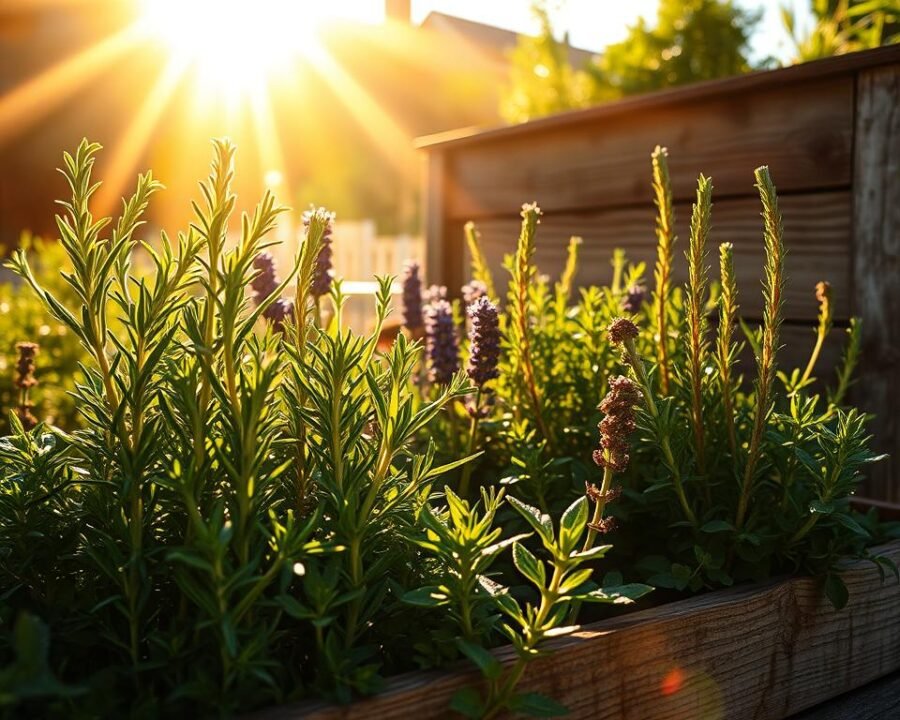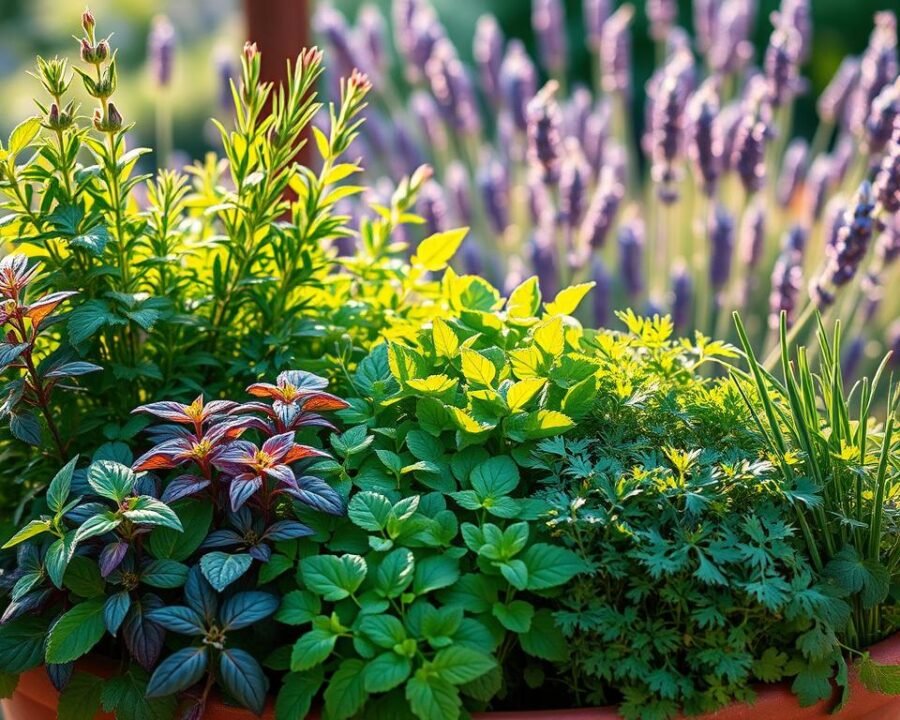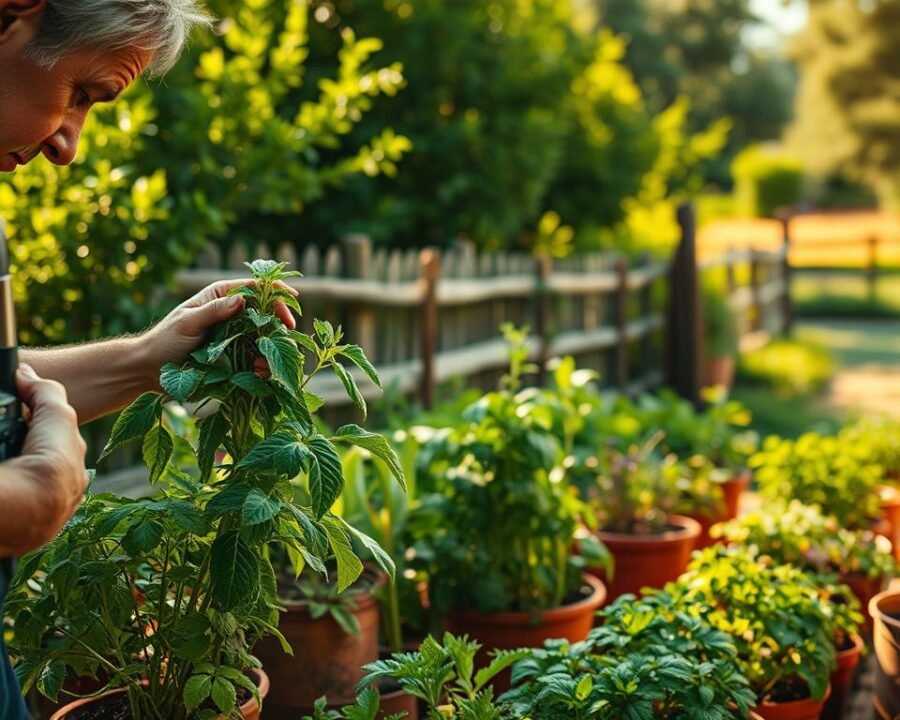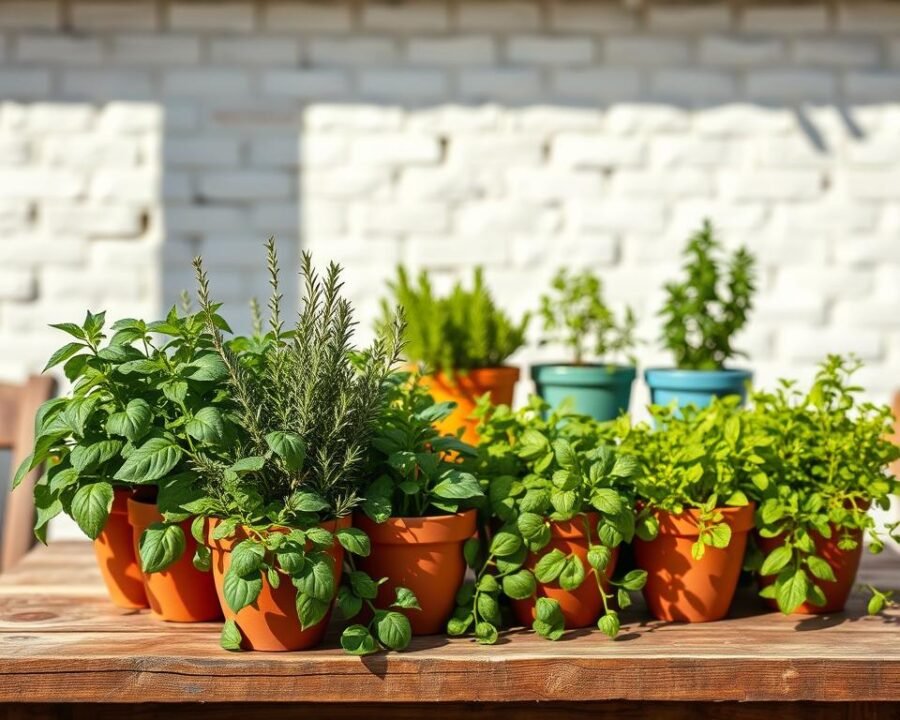There’s something magical about snipping fresh herbs straight from your kitchen windowsill. No more wilted store-bought bundles—just vibrant flavors at your fingertips. Whether you live in a cozy apartment or a spacious home, a container garden brings nature closer.
Urban dwellers and small-space enthusiasts love the simplicity of growing their own. Chives, basil, and mint thrive with minimal effort, making them perfect for beginners. Plus, cultivating your own supply saves money and ensures year-round freshness.
For those just starting, the EarthBox system offers an easy, foolproof way to nurture a thriving herb garden. No guesswork—just lush, aromatic greens ready to elevate every meal.
Key Takeaways
- Container gardening suits urban and small spaces perfectly.
- Low-maintenance options like chives are ideal for beginners.
- Homegrown herbs cut costs compared to store-bought ones.
- Fresh flavors are always within reach for cooking.
- The EarthBox simplifies the process for first-timers.
Why Grow Herbs in Containers? (And Why It’s a Game-Changer)
Urban living doesn’t mean sacrificing homegrown taste. Compact setups let you cultivate fresh herbs even in tight spaces. From balconies to windowsills, these portable gardens adapt to your lifestyle.
Space-Saving Benefits for Urban Gardeners
Apartment dwellers thrive with 6–8″ pots. Thyme, oregano, and chives fit perfectly on a patio or balcony. No yard? No problem. The EarthBox Junior stacks neatly against walls, maximizing every inch.
Mobility is a perk. Move plants to chase sunlight or shield them from harsh weather. One gardener grew mint indoors all winter using simple grow lights—*freshness at your fingertips* year-round.
Fresh Herbs at Your Fingertips Year-Round
Skip the store. Homegrown basil or parsley costs pennies compared to supermarket bundles. Three herbs thrive with just 4 hours of daily light:
- Parsley: Hardy and shade-tolerant.
- Cilantro: Quick to regrow after trimming.
- Chives: Resilient in partial sun.
With a container, you control soil and climate. Extend your harvest by bringing pots indoors when temperatures drop.
Choosing the Perfect Container for Your Herbs
The secret to thriving herbs starts with smart container choices. A well-picked pot ensures healthy growth and easy maintenance. Let’s explore the best options for your leafy companions.
Material Matters: Terra Cotta, Plastic, or Ceramic?
Each material impacts moisture and root health differently. Here’s a quick comparison:
| Material | Pros | Cons |
|---|---|---|
| Terra Cotta | Breathable, prevents overwatering | Heavy, dries out fast |
| Plastic | Lightweight, retains moisture | Poor airflow, risks root rot |
| Ceramic | Stylish, stable for indoor use | Expensive, often lacks drainage |
For rosemary, pick a 10–12″ deep planter. Its long roots need space to stretch. Ceramic works well indoors, while terra cotta suits sunny patios.
Drainage Holes—Non-Negotiable for Healthy Roots
Without holes at the bottom, water drowns roots. Drill your own if needed—even IKEA pots can be modified with a ¼” bit.
Pro tip: Avoid glass containers. A gardener lost a rosemary plant to stagnant water trapped in a sealed jar. Airflow is key!
The Best Soil Mix for Thriving Container Herbs
Healthy roots start with the right foundation—your soil mix makes all the difference. Unlike garden beds, pots need lightweight, aerated blends to prevent suffocated roots. Get this right, and your oregano or basil will reward you with explosive growth.
Why Garden Soil Is a No-Go
That bag of backyard dirt? It’s a death sentence for potted herbs. Garden soil compacts quickly, choking drainage and starving roots of oxygen. Test it yourself: Stick a fork into wet garden soil—if it resists, your herbs will struggle.
Opt for potting mixes instead. Brands like FoxFarm and Miracle-Gro offer blends with:
- Perlite: Tiny white balls that boost airflow.
- Vermiculite: Holds moisture without waterlogging.
- Balanced pH (6.0–7.0) to prevent bitter cilantro.
Key Ingredients: Perlite, Vermiculite, and pH Balance
Think of your mix as a recipe. Equal parts peat moss, compost, and perlite create a fluffy base. For DIYers, swap peat with eco-friendly coconut coir—it resists compaction and retains water like a sponge.
“pH imbalances stunt growth. I saved my parsley by testing with $5 strips—turns out my tap water was too alkaline!”
Spot poor soil early:
- Yellow leaves = soggy conditions.
- Stunted growth = compacted blend.
- Mold on surface = poor airflow.
Sunlight Needs: Full Sun vs. Partial Shade Herbs
Bright light or soft shade? Matching herbs to their ideal spot ensures lush growth. South-facing windows deliver 6+ sunlight hours, while northern exposures suit shade-preferring varieties. We’ll help you decode each plant’s preferences.

Herbs That Soak Up the Sun
These Mediterranean natives demand direct light for 6-8 daily hours:
- Basil: Develops richer flavor in strong light
- Rosemary: Needs afternoon shade in hot summer climates
- Thyme: Tolerates reflective heat from paved surfaces
Watch for leggy stems—they signal insufficient light. Rotate pots weekly to prevent lopsided growth. Our favorite trick? Use GE Grow Lights for dark apartments.
Herbs Happy in Shadier Spots
These varieties flourish with just 4 hours of morning sun:
- Mint: Spreads rapidly in damp, shaded corners
- Parsley: Maintains vibrant color without direct light
- Cilantro: Bolts less quickly when protected from midday rays
“My north-facing kitchen window grows perfect mint year-round. The secret? A simple $15 grow bulb for winter months.”
Identify sunburn on sage by crispy brown edges. Three office-friendly options thrive under fluorescent lights:
- Chives
- Lemon balm
- Chervil
Watering Wisdom: How Much Is Just Right?
Watering mistakes can make or break your container herb garden. Too little, and leaves crisp up; too much, and roots drown. Learn to read your plants’ signals and adapt to their needs.
Moisture-Loving Herbs
Basil and chives thrive in consistently damp soil. Let the top inch dry slightly, then water deeply. The knuckle test works wonders—stick a finger in the pot. If it’s dry past your first knuckle, it’s time to hydrate.
Clay pots dry faster than plastic. For busy gardeners, self-watering EarthBoxes maintain ideal conditions. A TikTok hack? Drop ice cubes near mint roots for slow, even moisture.
Drought-Tolerant Varieties
Rosemary and sage prefer dry spells between waterings. Wait until the soil feels crumbly 2 inches down. Overwatered thyme shows:
- Yellowing lower leaves
- Mushy stems
- Fungus gnats hovering
“I killed my oregano by misting—fuzzy leaves trap moisture and rot.”
Match your routine to the plant’s roots. Mediterranean natives like rosemary crave neglect, while tropical basil demands attention. Observe, adjust, and your herbs will flourish.
Companion Planting: Herbs That Grow Well Together
Pairing the right herbs creates a thriving mini-ecosystem in your pot. Some combinations boost growth, while others compete fiercely for space. Let’s explore which plants make ideal neighbors and which need solitude.

Perfect Pairs for Shared Containers
Basil and parsley are a match made in herb garden heaven. Both crave consistent moisture, making them easy to water together. A 12″ window box comfortably holds:
- Lemon balm, marjoram, and stevia
- Thyme and parsley
- Sage and chives
Rosemary and thyme thrive as Mediterranean roommates. Their similar drought tolerance means less guesswork for you. According to container gardening experts, these pairings yield better flavor and pest resistance.
The Mint Conundrum: Isolation Required
Mint’s aggressive runners invade neighboring plants within weeks. Contain it by planting in submerged nursery pots—this blocks underground spread while allowing drainage. Our failed cilantro-dill experiment taught us:
- Dill overshadowed cilantro within 3 weeks
- Both bolted prematurely from root competition
- Flavor profiles clashed in shared dishes
Four powerhouse herbs naturally repel aphids when grouped:
- Rosemary
- Thyme
- Sage
- Chives
“Basil near tomatoes isn’t just folklore—my patio pots produced sweeter fruits with this pairing.”
Remember: Perennial mint family members need solo 12-24″ pots. Annuals play nicer together but still require monitoring for overcrowding.
Herb-Specific Tips for Basil, Mint, Rosemary, and More
Mastering individual herb needs unlocks their full potential. While general care principles apply, each plant thrives with unique attention. We’ll share targeted techniques for popular varieties.
Encouraging Bushy Basil Growth
Pinch basil stems just above leaf nodes to stimulate branching. This creates fuller plants with more harvestable leaves. Follow these steps:
- Wait until stems have 3-4 sets of leaves
- Use clean fingernails or snips just above the second set
- Repeat every 2-3 weeks during summer
“My basil yield tripled after learning to pinch properly—now I share cuttings with neighbors!”
Pruning Mint to Prevent Takeovers
Contain mint‘s aggressive spread with the 2-inch rule. Never let stems grow beyond this length before trimming. Essential tools for the job:
| Tool | Best For | Tip |
|---|---|---|
| Micro-tip snips | Precise cuts | Disinfect with alcohol wipes |
| Herb scissors | Bulk harvesting | Cut at 45° angles |
| Bypass pruners | Woody stems | Sharpen blades monthly |
For rosemary, gradually acclimate potted plants to outdoor conditions over 7 days. Start with 2 hours of morning sun, increasing exposure each day. Avoid fall propagation—new mint plants need 8 weeks to establish before frost.
These focused techniques help each herb perform at its best. Whether you’re shaping basil or taming mint, small adjustments make big differences.
Troubleshooting Common Container Herb Problems
Even the most carefully tended herbs can run into issues. Spotting early warning signs helps you take action before problems escalate. Let’s decode what your plants are trying to tell you.

Yellow Leaves? Overwatering Might Be the Culprit
Soggy soil is the top killer of potted herbs. When roots can’t breathe, they rot—and yellow leaves are their distress signal. Check these five discoloration patterns:
- Uniform yellowing: Classic overwatering
- Yellow with brown spots: Fungal infection
- Vein-only yellowing: Nutrient deficiency
- Lower leaves yellow first: Natural aging
- Patchy yellow: Pest damage
Rescue drowning plants fast. Unpot them, trim black roots, and replant in fresh mix. For chronic overwaterers, try the self-watering pots recommended by experts.
“My basil bounced back after I switched to watering only when the pot felt light—no more guessing games.”
Leggy Herbs? They Need More Sun
Stretched stems reaching for light weaken your garden‘s productivity. Mediterranean varieties like rosemary show this most dramatically. Three solutions for low-light conditions:
- Rotate pots 90° every watering
- Use reflective surfaces (white walls, aluminum foil)
- Install compact grow lights (12 hours daily)
For etiolated sage, try the “scratch test”—gently scrape a stem. Green underneath means it’s salvageable with proper light. Brown indicates permanent damage.
Bonus Fixes for Common Issues
Mold on soil? Sprinkle cinnamon—a natural fungicide. Whiteflies? Yellow sticky traps work wonders. Remember: prevention beats cure. Monitor your herbs weekly, and they’ll stay thriving.
Extending Your Harvest: Indoor Herb Gardening in Winter
Winter doesn’t have to end your fresh herb supply—with the right setup, you can enjoy vibrant flavors all year. Moving plants inside requires planning, but the reward is a thriving kitchen garden when snow falls outside.
Grow Lights for Low-Light Months
Shorter days demand artificial sun substitutes. Full-spectrum bulbs mimic natural light best, while LEDs save energy. Consider these options:
- LED panels: Energy-efficient with adjustable intensity
- Fluorescent tubes: Affordable for multiple pots
- Smart plugs: Automate 12-hour daily cycles
Place lights 6-12 inches above herbs. Rotate plants weekly for even exposure. Our favorite combo? GE Grow Bulbs with timer outlets.
Moving Pots Indoors Without Shock
Abrupt changes stress plants. Follow this 7-day hardening-off schedule:
- Day 1-2: 2 hours indoors
- Day 3-4: 4 hours with humidity tray
- Day 5-7: Overnight in final location
“My EarthBox made transition effortless—roots stayed protected during the move.”
Three herbs naturally slow growth in winter:
- Lemon balm
- Tarragon
- Oregano
Combat dry home air with pebble trays. Fill a shallow dish with water and stones, then place pots on top. This creates a microclimate without overwatering.
Conclusion: Start Your Container Herb Garden Today
Transform your cooking with flavors picked straight from your windowsill. With compact setups, even tiny spaces yield fresh herbs for your kitchen. Beginners thrive with forgiving varieties like chives or basil—no yard required.
The EarthBox starter kit simplifies everything. Just add water, and watch your garden flourish. Share your harvests online using #HomeGrownFlavors to inspire others.
Ready to begin? Follow this quick list:
- Start basil in late spring for peak summer growth
- Pair rosemary with thyme in a 12″ pot
- Download our free companion planting guide
Your home deserves the joy of snipping fresh sprigs anytime. Let’s get planting!
